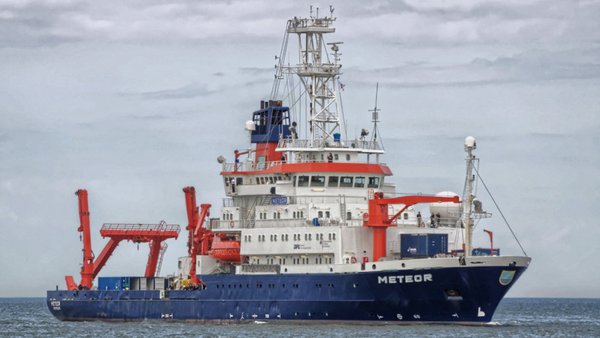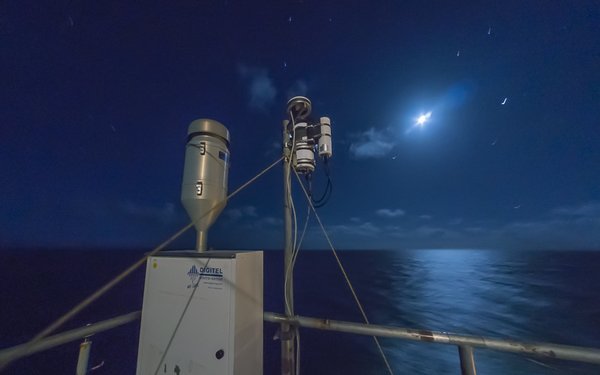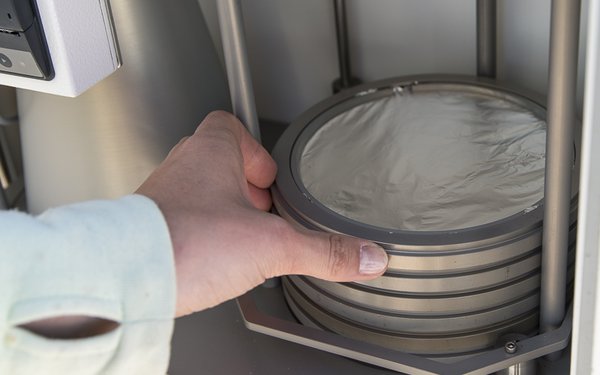METEOR expedition „BioChemUpwell“ takes a close look at upwelling zones in the Baltic Sea
Rostock/Leipzig, 28.07.2015
Chemists of TROPOS investigate exchange processes between ocean and atmosphere
On July 23, 2015, the FS METEOR set to sea for her second big research cruise this year. Starting from the port of Hamburg, the German open sea research vessel will spend the first month of the four-month expedition in the Baltic Sea. Under the lead of the Leibniz Institute for Baltic Sea Research Warnemünde (IOW) the research focus of this leg of the expedition lies on biochemical processes of upwelling zones in the Gotland Basin and the Gulf of Finland.
Upwelling is a process, which is initiated by certain wind regimes. Deep water that differs significantly from upper water layers is transported to the surface of the sea. Screened from the sun, it is much colder and enriched with nutrients and other dissolved substances, which have been released into the water by microbial degradation of organic matter at the sea floor. The surface water, on the other hand, is significantly warmed up by solar energy during summer and mostly depleted of nutrients. “Upwelling zones are quite frequent in the Baltic Sea, but sometimes exist only for a few days. They are exciting ‘hotspots’ for marine researchers, because a lot is going on there. The temperature drop, but mostly the supply of fresh nutrients alters the environment for the communities of planktonic organisms as well as the conditions for air-sea exchange processes on a very small temporal and spatial scale,” comments Günther Nausch on the research focus of METEOR cruise 117 titled “BioChemUpwell”. As deputy chief scientist, the longstanding IOW expert for marine chemistry and matter cycles is responsible for the scientific coordination of the cruise together with chief scientist Oliver Wurl from the Institute for Chemistry and Biology of the Marine Environment (ICBM) in Oldenburg. “To study the upwelling events from as many angles as possible, five project groups from three different research institutions have joined forces to take advantage of the synergies of such a collaborative expedition,” adds Nausch.
26 scientists in total, amongst them 20 IOW researchers, participate in the METEOR cruise 117 as scientific crew. Group 1 under the lead of IOW addresses the interaction of the cold upwelling water, which transports nutrients – especially phosphorus– upwards, and the development of cyanobacteria blooms. The research aims at supporting a better forecast and management of those blooms, which are potentially harmful for animals and humans. Group 2, headed by ICBM, explores the impact of the CO2 enriched deep water of upwelling systems on carbon fluxes and primary productivity at the surface. In particular, the researchers investigate the formation of the micro-layers within upwelling zones and their impact on the air-sea CO2 exchange by using highly developed sensors as well as in-situ sampling devices especially developed for this expedition. Group 3 under the lead of the Leibniz Institute for Tropospheric Research (TROPOS) also concentrates on the interface of sea and atmosphere: The scientists analyze the effect of upwelling zones on the composition of aerosols as these airborne climate relevant particles are significantly influenced by what kind of micro-layers exists on the sea surface. Group 4 under IOW lead investigates the sources of organic mercury compounds in oxygen depleted deeper water layers. Furthermore, the group analyzes, how the upward transport affects these substances and if – by consequence – an air-sea gas exchange of volatile mercury compounds increases the biological availability of these pollutants. Group 5, also headed by IOW, examines, how the energy turnover within zooplankton communities changes in response to varying food quality. Such variability can be caused by upwelling events as they significantly affect the composition of phytoplankton, on which the zooplankton feeds. Last but not least, IOW project group 6 is responsible for the data collection within various long-term monitoring programs. This includes the measurement in varying depths of temperature, salinity and the concentration of nutrients, oxygen, and chlorophyll as well as the survey of phyto- and zooplankton composition.
The METEOR’s track to the Eastern Gotland Basin and to the Gulf of Finland is in parts flexible as the occurrence of upwelling zones cannot be predicted in time and space. “We will be able to recognize the current position of an upwelling zone by our routine measurements on board as the key parameters of the cold water from deeper layers differ very recognizably from those of the surface water. In addition, we will cooperate closely with our land-based IOW colleagues from the remote sensing team, who will constantly supply us with satellite information on the sea surface temperature and the occurrence of sudden cold spots, which typically indicate an upwelling event,” explains Günther Nausch. The METEOR cruise 117 will be concluded on August 17, 2015, in Rostock, where the scientific crew of this particular part of the expedition will disembark. Afterwards, three more cruise legs will lead the METEOR into the Atlantic with her final destination in the port of Walvis Bay/Namibia. More information on the research vessel METEOR: www.portal-forschungsschiffe.de/index.php?index=53





